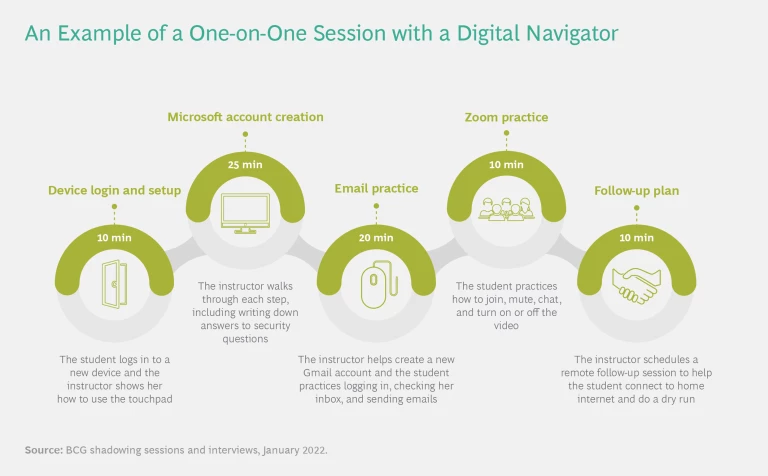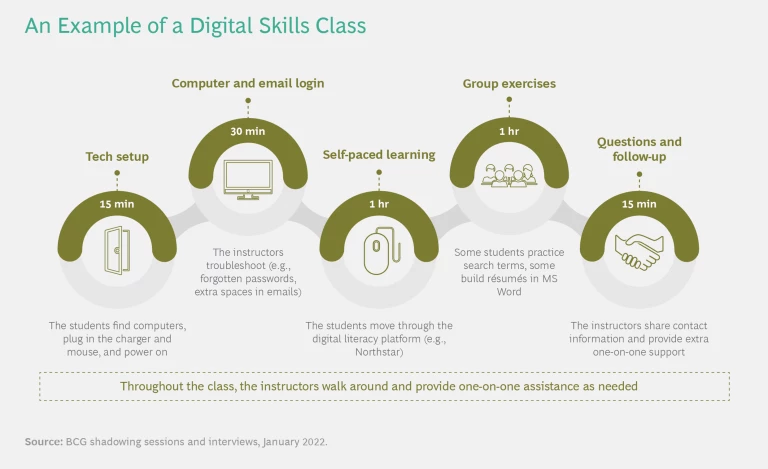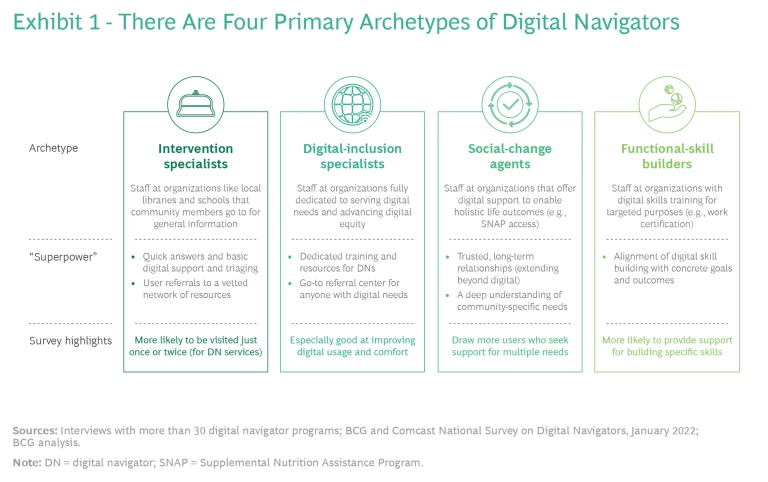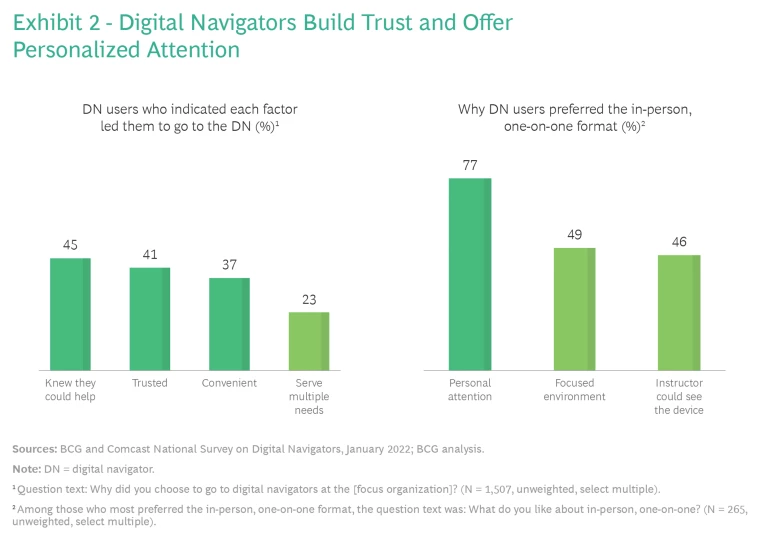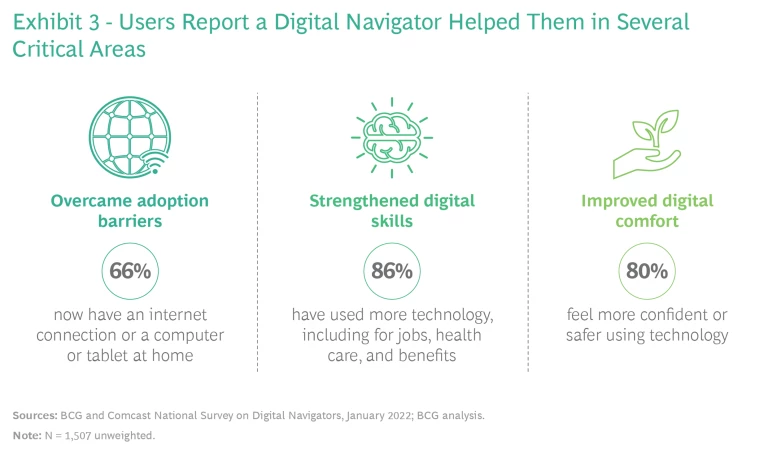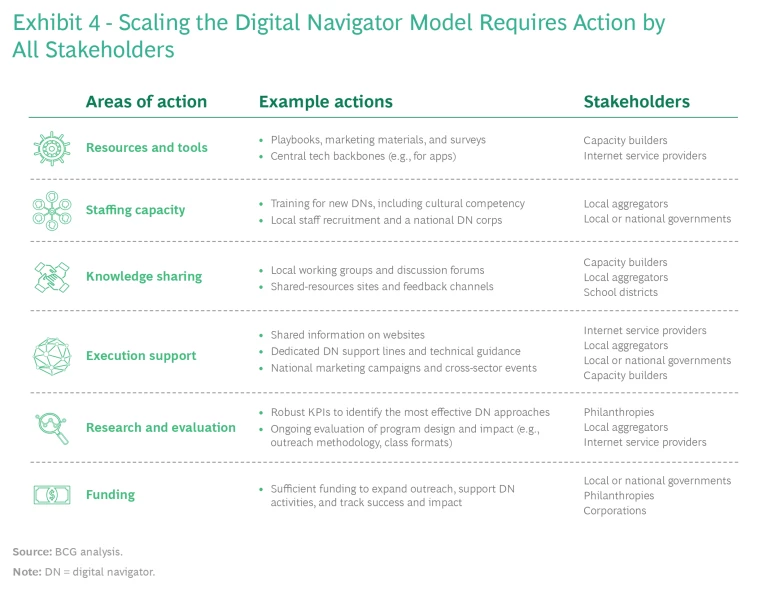Nearly 20% of Americans lack broadband access or a device to tap into the internet. Digital navigators—individuals trained to help people get online—can bridge the gap.
There has been a major push in recent years to bridge the digital divide in the US. Yet, nearly 20% of Americans—disproportionately low-income, Black, Hispanic, and rural populations—lack a broadband connection or a digital device at home according to the 2020 US Census. This disparity exacerbates existing barriers to pursuing an education , earning higher incomes, and obtaining essential services such as health care and financial services. Case in point: a lack of internet access was one factor consistently linked to a high risk of death due to COVID-19, according to research published in JAMA Network Open.
Why does the digital divide remain so wide? One reason is that a key driver of the problem has gone largely unaddressed. The disparity in digital access stems from barriers in three areas: availability, affordability, and adoption. To date, most efforts aimed at closing the gap have focused primarily on the first two categories and less so on the third. Although investments by government and private sector players to build out the requisite infrastructure and make internet service affordable are critical, the benefits will not be fully realized if households do not adopt and use the services .
One reason the digital divide remains so wide is that a key driver of the problem—adoption—has gone largely unaddressed.
The good news is that there is a powerful, proven tool for solving the adoption piece of the puzzle: digital navigators. Digital navigators are trained individuals, typically based in a community organization, who provide tailored support for the full spectrum of digital inclusion needs, from internet and device access to digital skill building. Community-based groups and municipalities across the country have been investing in digital navigator programs over the past several years, with investments accelerating since the start of the pandemic. Our research, including a survey of more than 1,500 people who have used programs staffed by digital navigators, found that:
- Thanks to the support of a digital navigator, over 65% of survey respondents reported that they were able to obtain internet access or a computer or tablet at home; more than 85% said they now use the internet more.
- Overall satisfaction with digital navigators was nearly 80%, with many users praising digital navigators for helping them quickly fix their issues and making them feel confident.
- Digital navigators are not monolithic: there are four distinct archetypes, each of which plays an important role depending on where people are in their connectivity journey.
But there’s a catch: as effective as these programs are, they remain underfunded and often operate on a small scale (some organizations support fewer than 50 individuals per year). That limits the number of people who can be helped and slows progress toward reaching universal broadband adoption. That’s why players across the
digital ecosystem
, including internet service providers (ISPs), device manufacturers and other corporations, philanthropies, and local, state, and federal governments, must collaborate to expand the reach and impact of digital navigators. These ecosystem players should take action in six enabling areas:
- Develop resources and tools, including a standardized digital navigator curriculum and assessments.
- Expand and diversify the ranks of trained digital navigators, including those who are culturally sensitive and speak multiple languages—a powerful lever for building trusted relationships in diverse communities.
- Create mechanisms for knowledge sharing among digital navigators.
- Provide execution support in the form of outreach campaigns and dedicated support lines.
- Invest in research and evaluation to improve program design and measure impacts.
- Increase funding, including money now available through the Infrastructure Investment and Jobs Act (IIJA), to support digital navigators directly and enable all other ecosystem actions.
At the same time, digital navigator programs can be even more effective at building trust and reaching larger numbers of people by adopting proven best practices, including those embraced by other successful public campaigns for health care enrollment and voter registration.
With the right resources and support, digital navigators can raise the awareness and uptake of low-cost internet programs. Among them: the 2021 IIJA’s Affordable Connectivity Program (ACP), which subsidizes internet service for millions of low-income households. In addition, digital navigators can expand access to devices and help people build digital skills. These actions will ultimately narrow the digital divide and expand opportunity for those Americans most at risk of being left behind in the digital age.
The Cost of the Digital Divide
The need for action to expand digital equity—already urgent before the pandemic—is even higher today and only likely to grow more so in the future. In the past, BCG has studied the impact of the digital divide, barriers impeding internet adoption, and steps needed to close the gap. This year, we took a close look at the role that digital navigators can play in addressing the problem. (See “Studying the Digital Divide.”)
Studying the Digital Divide
This builds on our previous research, which included surveys of roughly 2,500 low-income households. That work revealed that even when low-income households with school-age children were eligible for no-cost broadband solutions offered by schools, 63% were unaware that they existed. Meanwhile, among those who knew about the programs, 29% had not applied because they were unsure of their eligibility.
Ultimately, our research found that a key element in overcoming these barriers is the expansion of trusted sources of support that can provide one-on-one assistance and digital skills instruction.
Digital inequity is inextricably linked to systemic and racial inequities. According to a 2021 Pew Research Center survey, while 20% of white Americans lack a broadband internet subscription, the figure is appreciably higher for Black and Hispanic Americans—29% and 35%, respectively. In addition to these racial disparities, people without broadband tend to have lower incomes and lower levels of educational attainment.
Digital inequity is inextricably linked to systemic and racial inequities.
Individuals with digital connectivity have greater access to education, employment, and health care services . A study of areas where Comcast’s Internet Essentials program (which offers free and discounted internet service options) is available found that households that adopted broadband were on average 8.1 percentage points more likely to be employed and earned on average $2,202 more in annual household income, according to results published in the American Economic Journal: Economic Policy. Additionally, the Philadelphia Federal Reserve has identified large gaps (7 to 17 percentage points) in labor force participation rates between those who have a computer with broadband access and those who do not Such outcome disparities between the digital haves and have-nots are likely to increase over time as digital access becomes even more deeply woven into the economy and life in general.
At the same time, digital inequity has implications for business and society broadly. According to Ecotone Analytics, every $1 invested in digital access creates $2.40 in societal returns including enhanced GDP growth and lower social-service spending.
The Role of the Digital Navigator
The pandemic has spurred significant investments in broadband affordability and availability. And these local, state, and federal funds are having an impact. For example, a 2021 Philadelphia Household Internet Assessment Survey done by Wilco found that the city of Philadelphia’s investment in and promotion of free and discount programs (including Comcast’s Internet Essentials, T-Mobile’s Project 10Million, the federal government’s Emergency Broadband Benefit, and Philadelphia’s school-sponsored PHLConnectED program) have helped push the share of households with high-speed connections from 70% before the pandemic to 84% in mid-2021. But many households in Philadelphia and elsewhere are still unaware of the available low-cost and free options or face additional challenges related to adoption, including low literacy rates, weak digital literacy skills, and housing insecurity.
This is where digital navigators come into play. These individuals can provide a variety of awareness building and digital support. They can educate community members about available, low-cost internet programs, help people secure a device and broadband connection (including offering assistance through the application and installation processes), troubleshoot tech issues, and teach digital skills (from the basics like using a mouse or creating an email address to more advanced skills such as filling out an online job application or using a spreadsheet). Essentially, these individuals serve as digital “case workers” who provide end-to-end support on the entire spectrum of digital needs, including helping people take full advantage of government programs for low-cost access. (See “Uncle Sam Wants You [Connected]!”)
Uncle Sam Wants You (Connected)!
The $14.2 billion Affordable Connectivity Program (ACP) provides a $30 monthly internet credit for eligible low-income
It’s likely that these unenrolled households have lower levels of literacy and digital literacy skills on average than those that adopted the program earlier. Consequently, these households may find the ACP online application process—which involves navigating through multiple websites and using digital skills like typing, clicking, and captcha—daunting. Without the sort of one-on-one support provided by digital navigators to walk them through this process, many of these unconnected households may not enroll in the program and consequently may remain unconnected to the internet, ultimately limiting both the reach and the benefit of the ACP.
The IIJA also includes the $42.5 billion Broadband Equity, Access, and Deployment (BEAD) Program, which supports primarily infrastructure expansion but can also be used for broadband adoption, and the $2.75 billion Digital Equity Act (DEA), which focuses exclusively on digital inclusion. Nearly all this funding will be given to states, which will be responsible for prioritizing and enabling the investments in broadband access and digital equity. Directing funds to digital navigators can maximize the impact that these individuals have in closing the digital divide and, in turn, ensure that the return on all infrastructure and cost subsidy investments is fully realized.
Digital navigator programs are offered by, or integrate their efforts with, various existing community organizations, ranging from nonprofits (used by 37% of survey respondents) to health centers (24%) and libraries (21%).
These programs come in many shapes and sizes. Some organizations (such as Boston-based Tech Goes Home) are dedicated entirely to digital inclusion. Others (including many local YMCAs) have digital navigators on staff as part of their broader mission. Certain groups provide support across the full spectrum of digital needs while others may help more narrowly—such as by handing out devices or running an internet sign-up campaign. In addition, programs exist in both urban and rural settings. Digital Charlotte, for example, ensures that everyone in the city and surrounding county can find and connect with available digital inclusion resources. Meanwhile, Rural Local Initiatives Support Corporation (LISC) operates through a network of 32 community organizations including health care and social service providers, across 20 states in the Appalachia region, deep South, upper Midwest, and Navajo Nation.
A number of digital navigators address systemic and racial inequities and have equity as one of their core values. Washington, DC–based Byte Back, for example, emphasizes its commitment to “building more equitable communities” and states explicitly that its “work is racial justice work.” Many digital navigators work with Black, Hispanic, immigrant, and other underserved communities, and are most effective and trusted when doing so in multiple languages and with staff who also reflect the population they serve.
Beyond formal programs with digital navigators, many organizations also have people on staff who act in this capacity without labeling their offerings as such.
As we watched digital navigators in action (in remote classes, group meetings, and one-on-one sessions) and spoke with users directly, we saw firsthand how patience, repetition, and smart questions and exercises—often over several hours—enabled people to build digital readiness. (See “The Personalized Connectivity Journey.”)
The Personalized Connectivity Journey
During one digital navigator session we shadowed (lasting more than an hour), the navigator helped a student set up a new device and build basic digital skills so that she could take her GED classes on Zoom. The learner began the session noticeably anxious and intimidated. The digital navigator eased those fears, helping her step by step to practice logging in to email and joining Zoom links. At one point during the Zoom training, she told the instructor, “Can we work on this more—I’m kind of lost.” The instructor wrote down clear instructions for her on sticky notes and scheduled another remote session during which the instructor could help the student connect to the internet at home. (See the exhibit “An Example of a One-on-One Session with a Digital Navigator.”)
When observing group classes, we again saw the benefits of personal attention. (See the exhibit “An Example of a Digital Skills Class.”) Group classes combine lectures with periods when learners engage in self-directed exercises and instructors move from student to student providing one-on-one support. In one case, an instructor helped diagnose that a number of participants had made mistakes (such as adding an unneeded space in their email address) when trying to sign in to their accounts. The classes also strengthened the bonds of community within the group by having students collaborate on activities.
Four Archetypes. To understand the universe of digital navigators, we looked closely at what they do and how they help people at different stages of their connectivity journeys. On the basis of those factors, we identified four digital navigator archetypes (see Exhibit 1):
- Intervention Specialists. These are staff at organizations like local libraries and schools that community members go to for general information, including questions related to online resources and access. Intervention specialists are particularly good at rapidly (in just one or two interactions) understanding where people are along their connectivity journey, providing quick answers to basic digital questions (for example, knowing what low-cost internet options exist), and connecting individuals with a broader network of vetted digital resources. Consequently, the intervention specialist may personally spend limited time on digital navigator work (relative to other tasks). This archetype can be a powerful tool—basic digital navigator training for all librarians and teachers would provide the vast majority of the US with easy access to a trusted source of digital support.
- Digital-Inclusion Specialists. These are staff at organizations fully dedicated to achieving digital equity. Many provide robust support across the full spectrum of digital needs. For instance, one digital-inclusion specialist we shadowed worked with someone for more than two weeks to provide the individual with end-to-end, “case worker”-style support, from helping sign up for the federal ACP to supporting the user’s internet application and installation processes. Other local organizations (including those with their own staff of digital navigators) may use the digital-inclusion specialists as a centralized source of materials and best practices for digital navigators and frequently refer people to these specialists if the organizations are unable to fully meet users’ digital needs. Digital-inclusion specialists are especially effective at helping people develop greater digital skills and comfort in the later stages of their digital journey.
- Social-Change Agents. This archetype comprises digital navigators who work at organizations such as the YMCA to enable the groups’ broader goal of supporting the holistic well-being of the populations they serve. As cornerstones of the local support system, social-change agents are distinguished by their intimate understanding of community needs, their population-specific language knowledge, and the trusted, long-term relationships that they foster with community members. The agents are especially well positioned to drive digital inclusion for time-constrained individuals who seek help with multiple needs at once. Social-change agents may, for example, conduct outreach by going door-to-door to offer support on a variety of issues, including food, health care, housing, and digital access. In this way, they have the unique ability to reach people who are highly disconnected from society in general.
- Functional-Skill Builders. This archetype provides digital skills training for targeted purposes, such as finding employment in certain fields, advancing education, or delivering health care services. In doing so, functional-skill builders closely align all digital programming with the “why” for skills and access. For instance, Jewish Vocational Service (JVS) Boston focuses on workforce development. As part of this broader mission, staffers teach a computer class that focuses specifically on digital health care skills for prospective certified nursing assistants. As digital applications become integrated into more and more sectors, including finance, education, and government, the number of organizations that serve as functional-skill builders will only continue to increase.
In many cases, a digital navigator program may be a hybrid of these archetypes. We find that all four models have a great impact, with similarly high user satisfaction. Ultimately, every municipality should have a mix of digital navigators from each of the four archetypes to ensure that individuals can find the right support according to where they are in their connectivity journey.
Consider community members who have never used the internet or a digital device before and are already working with a social-change agent for support in their native language. That social-change agent can first teach such individuals about the benefits to be gained by going online and then begin helping them build foundational digital skills, such as using a mouse and browsing the internet. Alternatively, if people know they want an internet connection but don’t know how to secure access at home, they may turn to an intervention specialist to ask questions about the sign-up processes and learn what other resources are available.
A Winning Relationship. The success of digital navigators is driven by a combination of trust and personal attention. (See Exhibit 2.) The best ones meet people where they are and provide digital support to those most in need.
Trust is paramount. One in three respondents had already worked with the organization providing digital navigator services on other matters. And nearly three-quarters first learned of the digital navigator program through trusted sources such as family, friends, or an organization’s staff members. Many programs prioritize recruiting staff and volunteers from the communities they serve, an approach that deepens local ties, makes users feel comfortable, and encourages participation. The presence of local staff and volunteers can be particularly valuable in building trust in vulnerable or historically underserved communities.
Individualized attention is also key. Survey respondents reported that they prefer engaging with digital navigators in person and one-on-one, with most users choosing this format whenever it was available. What’s more, 85% of those who received such personal attention were satisfied with the experience. As one Beyond Literacy participant says, “Instructors are very talented, fun to learn from, and go above and beyond to help.”
Evidence of Impact. Our survey found that digital navigators are highly effective in driving digital adoption, usage, and comfort. About two-thirds of respondents reported that they now have internet service or a computer or tablet at home thanks to the support of a digital navigator. In addition, 86% of respondents indicated they have used technology more often since engaging with a digital navigator and 80% feel more confident or safer using technology. (See Exhibit 3.) With the assistance of digital navigators, almost half of respondents obtained better health care; over 40% received support with basic needs such as food, rent, and housing; and more than one in three found a new job or earned a higher income. As one participant of a program offered by Boston-based Tech Goes Home says, “This was a great experience… [that] gave me the opportunity to get more comfortable with technology to then get a new job.”
Others say that the programs broadened the scope of their world, enabled them to have the technology they need for their children to do schoolwork, and allowed them to connect with family and friends. In this way, digital navigators are essential to both closing the digital divide and reducing socioeconomic inequalities.
Moreover, nearly 80% of respondents are satisfied with the support they received from a digital navigator. The top three emotions that respondents associated with digital navigators were: “happy,” “satisfied,” and “confident.” Two key factors drove this satisfaction: digital navigators were able to fix the individual’s issues quickly, and the programs they participated in were convenient. Many also appreciated that their digital navigator could address multiple needs at once. Finally, the population served by digital navigators often has significant time constraints, and digital navigators meet this population where they are and cater to their needs.
The impact and experience, however, differ slightly depending on the race and ethnicity of the user. Black and Hispanic respondents reported even higher increases in digital adoption and usage due to their work with digital navigators than non-Hispanic white respondents. Our survey found that 72% of Black and Hispanic respondents now have internet service or a device at home thanks to a digital navigator, compared with 64% of non-Hispanic white respondents. In addition, Black and Hispanic users were more likely to have applied for a job or benefits or received help with school because of the support they got from digital navigators.
Survey respondents’ satisfaction with digital navigator programs differs slightly depending on the race and ethnicity of the user.
But Black and Hispanic users also have lower satisfaction rates: 70% and 77% of those respondents, respectively, reported they are satisfied versus 82% of non-Hispanic white respondents. The key drivers of dissatisfaction cited by Black and Hispanic users include logistical barriers, such as inconvenient hours, and what they perceived to be a lack of respect from, or connection to, digital navigators. Many organizations we spoke with are aware of this dynamic and are taking action to better support their communities, including offering digital navigator programs in multiple languages and recruiting instructors locally. For example, Esperanza, a Philadelphia-based organization with a mission to strengthen Hispanic communities through education, economic development, and advocacy, emphasizes that it hires “volunteers from the community because if it’s not coming from a trusted community member, it won’t be well received.”
The Need for Scale—and How to Deliver It
Despite the impact delivered by digital navigators, the network of navigators remains significantly limited owing to funding and capacity constraints. In fact, some of the organizations we interviewed serve fewer than 50 people per month. But this can change with the right action.
Funding and Capacity Limitations. Today, digital navigators are funded largely by their parent organization or through grant programs. The San José Digital Inclusion Fund, for example, is a public-private partnership that disburses up to $1 million each year to organizations closing the digital divide, including those offering digital navigator programs. The fund pays $350 to community groups for each successful broadband adoption, which it defines as an individual having an internet connection at home, a digital device, and basic digital skills such as the ability to search the web and send and receive email.
The capacity constraints, meanwhile, reflect that digital navigator work is a time-consuming exercise. Digital navigators report they often spend three or more hours trying to help someone understand and sign up for low-cost internet and device programs.
In one case we shadowed, the digital navigator spent some initial time with the client to build trust and rapport. The navigator then devoted several hours to teach and practice basic skills (like how to use a mouse or set up an email account), address questions and concerns (including those related to providing personal information), and resolve issues (such as calling the federal hotline for ACP applications after certain initial documents were rejected). The time demands are often compounded by the fact that someone may come in for one thing but need support on multiple matters.
In another case, an individual came to a digital navigator to sign up for the ACP but actually needed support on multiple things such as creating an email address. The digital navigator had to allocate additional time to help the community member select a username, choose and write down a password, and set up and practice using the account.
The combination of funding and capacity constraints has a number of impacts:
- Digital navigators rely heavily on word of mouth to build their user base.
- Many lack the resources to tailor their programming to population-specific needs, which can leave Black, Hispanic, and non-native English-speaking users feeling sidelined.
- Digital navigators have a limited ability to capture data, track KPIs, or conduct research to improve their programs.
- They often operate in silos and struggle to identify best practices or coordinate with other local resources. The result is that many digital navigators reinvent the wheel, individually creating and tailoring training programs, intake forms, and the like.
Two Levels of Action. Scaling up and increasing the overall effectiveness of the digital navigator model is entirely possible, however. Our research, as well as the success of activation campaigns including health care enrollment and voter registration, points the way forward. (See “Getting Schooled on Campaigns.”)
Getting Schooled on Campaigns
Take the effort by the US government to build a roster of certified application counselors to drive awareness and adoption of health care options under the Affordable Care Act. The government rigorously trains counselors, many of whom are based in community health centers and hospitals, not only on the technical health basics but on the soft skills needed to support vulnerable and underserved populations. In addition, counselors have the credentials to access application information for the people they are helping, ensuring that the counselors stay up to date and can best support individuals through the process. In parallel, pharmacies like HealthSource established dedicated lines for counselors to call and speak with more experienced service representatives about technical insurance questions, leading to a faster and more seamless resolution of issues.
Meanwhile, Rock the Vote—a nonprofit focused on voter turnout—tapped human capital (including celebrity influencers like Michelle Obama and Steph Curry) to get the word out, and made some smart technology investments. The organization established a tech backbone that enabled more than 1,000 other groups to register voters in a streamlined, coordinated way.
We recommend two levels of action—steps by stakeholders across the entire digital navigator ecosystem and steps by organizations that offer digital navigator programs.
Ecosystem stakeholders include not only digital navigators but also local digital navigator aggregators (community entities that lead knowledge-sharing initiatives), capacity builders (national nonprofits that create some basic foundational resources and advocate on behalf of digital navigators), philanthropies, ISPs, device manufacturers, school districts, and local, state, and federal government representatives. Stakeholders should take action in six critical areas (see Exhibit 4):
- Resources and Tools. Capacity builders and ISPs should develop robust playbooks, outreach and marketing materials, surveys, and tech backbones that digital navigators should use and adopt. These resources are especially important in rural areas, where digital navigators are often dispersed and operating independently at a very small scale. When building resources, it’s also important to keep in mind that the necessary materials may differ by digital navigator archetype. Intervention specialists, for example, need pamphlets with basic information such as details on affordable internet options, while social-change agents require playbooks and training modules that they can tailor to their populations’ needs. Organizations have already begun to invest in these tools: the membership-driven trade association National Digital Inclusion Alliance developed a digital navigator playbook, and Northstar, a program of Literacy Minnesota, offers online digital skill assessments.
- Staffing Capacity. Local aggregators should help build out the ranks of trained digital navigators by, for example, recruiting student volunteers from local schools and providing standard resources for training new digital navigators. Lead for America, for instance, is a nonprofit that pays recent college graduates to serve as full-time digital navigators in rural and urban communities. Establishing a national digital navigator corps could prove incredibly useful, with instructors who possess strong technical and soft skills as well as keen cultural awareness. Recruitment should focus on attracting instructors who reflect the population they are serving, and training should include cultural competence and language assistance relevant to the community.
- Knowledge Sharing. Capacity builders, local aggregators, and school districts should develop mechanisms for collaboration among digital navigators, including working groups and discussion forums, shared-resources sites, and channels for providing feedback. Knowledge-sharing sessions can also be used to help digital navigators coordinate their activities, ensuring that there is at least one organization targeting all the local populations that need to be reached. In some municipalities, broadband coalitions with stakeholders from the public, private, and social sectors act as local aggregators and play this knowledge-sharing role. For example, the Maine Broadband Coalition is a network of public, educational, business, nonprofit, government, and individual leaders that “share information, resources, and knowledge to increase the ability of community leaders to understand, plan for, and implement broadband expansion and inclusion initiatives.” These municipal broadband coalitions should include knowledge sharing related to digital navigators in their efforts.
- Execution Support. ISPs, local aggregators, and state and federal governments should build awareness of digital navigator programs by sharing information on their websites and should consider establishing dedicated support lines to answer questions and resolve issues for digital navigators. These stakeholders, along with capacity builders, should also seek opportunities to bolster national marketing campaigns (such as Digital Inclusion Week) to raise awareness of digital navigators among potential participants or to integrate digital navigator programming into the initiatives of other stakeholders such as employers and health care providers.
- Research and Evaluation. Philanthropies, local aggregators, and ISPs should conduct ongoing data collection and analysis to identify the populations who need to be reached and track progress toward increasing broadband adoption. In addition, they need to establish a robust set of KPIs to evaluate digital navigator programs—including the number of users helped by race, ethnicity, or other demographic group and the number of users who increased digital adoption and usage—and then use this information to identify the most effective approaches. They should conduct research to improve program design by evaluating, for example, the impact of different outreach methodologies and class formats or exploring ways to streamline the application and installation process for internet access.
- Funding. Local and federal governments, along with philanthropies and corporations, should ensure that sufficient funding is available to expand digital navigator programs. Increased funding should be used to support the activities of digital navigators, including community outreach to households that are unconnected or have low digital literacy, and to evaluate the impact of those activities. Expanded funding can also underpin activities in the other five enablement areas.
In addition, digital navigator programs should adopt some clear best practices to amplify their impact:
- Invest in robust referral systems from other trusted local organizations as well as family-and-friend networks to increase the number of people participating in the programs.
- Hire staff from the local community with an emphasis on soft skills, not just technical acumen, to ensure that individuals, especially Black and Hispanic users, feel safe, respected, and supported.
- Consider ways to make programs more accessible, such as by including weekend hours, recording classes for later viewing, or offering services in multiple languages.
- Prioritize one-on-one interactions, especially for beginners, with group instruction as learners advance; consider channels to increase staffing, such as recruiting and training volunteers from local schools.
- Avoid reinventing the wheel by leveraging available resources for marketing materials, curriculum, assessments, and tracking. Push for local networks and partnerships to improve resource sharing and reduce the burden on your organization.
- Embed evaluations into the design of programs, conducting intake assessments, researching the effectiveness of programs, and measuring their impact on digital and socioeconomic outcomes.
- Act as the voice on the ground for understanding community needs and identify opportunities to share feedback and escalate concerns—for example, through the working groups coordinated by the National Digital Inclusion Alliance and supported by Digital US.
Digital inequity has significant costs, including reduced access to education, employment, health care, and income for some of the most disadvantaged members of society. These costs will likely be even higher in a postpandemic world in which remote work and online social-service delivery become the norm.
As the federal government makes unprecedented investments in closing the digital divide and looks to reach its goal of universal broadband access, ensuring both availability and affordability is critical. But the government must also address adoption barriers and digital skill building to increase digital equity. Those who have access available to them, but are not yet connected, are among the hardest-to-reach populations. Digital navigators are a proven, effective model for driving digital adoption and boosting digital usage and comfort in order to reduce systemic inequities. These navigators leave participants feeling confident and capable through a combination of trust, personalized attention, and an ability to address the needs of vulnerable and underserved communities with respect, competence, and patience.
Today, however, such programs are still in their infancy. Scaling them demands action by players across the ecosystem. Scale will require increased funding. At the same time, ecosystem players should take action to improve efficiency through resource sharing, clear and effective playbooks, and continued data collection and analysis to identify and expand the most effective programs. In the coming months, states and municipalities will receive significant funding from the IIJA. To effectively boost digital inclusion and increase the uptake of low-cost internet offers (including through the federal ACP), it is incumbent on all levels of government—local, state, and federal—to direct funding toward broadening the capacity of digital navigators and the associated ecosystem.
As the public and private sectors invest to scale the digital navigator ecosystem, they must keep in mind that the drive to expand digital inclusion will by necessity be a sustained one. Digital innovation continues unabated across sectors and digital skill requirements continue to grow. Consequently, digital navigators will remain essential to ensuring that every American is equipped to thrive in the digital age of today and the future.
Acknowledgments
We thank the following organizations for opening their doors and allowing us to shadow their digital navigators and survey their program participants: Beyond Literacy (Philadelphia, PA); Byte Back (Washington, DC); Jewish Vocational Service Boston (Boston, MA); Multnomah County Library (Portland, OR); Southeast Asian Mutual Assistance Association Coalition (Philadelphia, PA); and Tech Goes Home (Boston, MA).
Thank you also to the following organizations, which took the time to speak with us and share insights from their experiences: California Emerging Technology Fund (San Francisco, CA); Chicago Public Library Foundation CyberNavigators (Chicago, IL); Community Tech Network (San Francisco, CA); Cuyahoga County Public Library (Cleveland, OH); Digital Charlotte (Charlotte, NC); Digital Inclusion Network (Portland, OR); Enoch Pratt Free Library (Baltimore, MD); Enroll America (Boston, MA); Esperanza (Philadelphia, PA); ExCITe Center at Drexel University (Philadelphia, PA); Fair Count (Atlanta, GA); Florida Rising (Miami, FL); Hester Street (New York, NY); Human Resource Development Center District IX (Boseman, MT); KC Digital Drive (Kansas City, MO); Mecklenburg County Library (Charlotte, NC); Metropolitan Area Planning Council (Boston, MA); National Digital Inclusion Alliance (Columbus, OH); Northstar (St. Paul, MN); Older Adults Technology Services (New York, NY); Propper Daley (Los Angeles, CA); Rhode Island Parent Information Network (Warwick, RI); Rural LISC Digital Navigator Program (nationwide); Salt Lake City Library Tech League (Salt Lake City, UT); San José Digital Inclusion Fund (San Jose, CA); and State Library of North Carolina (Raleigh, NC).
This report was developed by Boston Consulting Group in partnership with Comcast.

